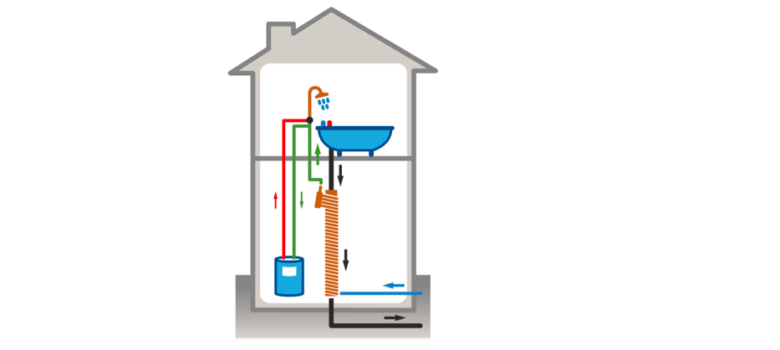
What is a WWHRS and how does it work?
Typically, a waste water heat recovery system works by extracting the heat from the water your shower or bath sends down the drain. This heat is used to warm the incoming mains water, reducing the strain on your boiler and the energy required to heat your water up to temperature. A system normally takes the form of a long vertical copper pipe, where the warm water runs alongside the colder mains water to exchange the heat.
The devices are typically around 60% efficient, so they convert 60% of the potential energy in the waste water back into heat for the incoming water. This can save you money on your bills, especially if you use a lot of hot water in your home. The payback period – as we will discuss – is another matter.
The good news is that it is a fairly simple device. It has no electrical components, no pumps or controllers, and so it requires very little maintenance. It has an expected lifespan of 20 years+. Unfortunately they are usually a little too expensive for the payback they generate in domestic dwellings, but this is beginning to change.
Is it worth retrofitting a WWHRS?
In some cases retrofitting may be possible, but the bulk and length of the recovery device means that most showers or baths wouldn’t be suitable. It is much easier to get it installed when you are fitting a new bathroom.
How much do they cost?
They typically start at around £600 + installation. So you are looking at over a £1,000 to get a unit in your home.
Are they worth it?
Until 2015, installers often used WWHRSs as a means to get a new home up to Sustainable Homes Code standards, rather than a means to save money. Now that the Sustainable Homes Code is no longer around, although you certainly will save some cash with a WWHRS, the payback period is not worthwhile for most people.
A typical saving on an average home might be £20-30 a year. So the payback time is around 40 years typically. Of course, if you use a lot of hot water, it can begin to look a bit more attractive.
Other ways to recover wasted heat
There really are better ways to cut your bills – reducing your hot water use is a great way to cut your bills. That means less time in the shower, fewer baths and using a dishwasher instead of washing up under running hot water. Doing fewer hot washes in your washing machine will also cut your energy use. This is a much better way to save £20 a year, instead of installing an expensive appliance like this.
Benefits
- Saves some money on your bills by extracting the heat from your waste water.
Limitations
- Can’t be easily retrofitted, only really viable on a new build property.
- Not normally cost-effective.
Cost
- About £1,000.
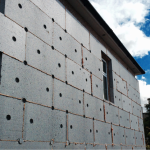
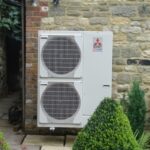


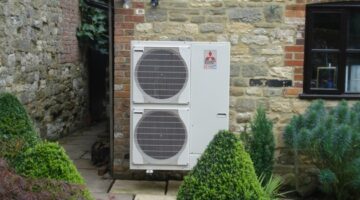
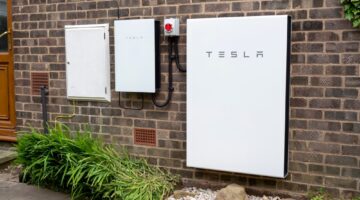






Hello
Can I ask where you got your information from? I have seen products for alot cheaper then the £600 you have quoted and want to make sure I am getting a good product?
Thanks
This is totally misleading information, for a start, WWHR units do not cost £600, and secondly, they save huge amounts of energy per year, from £150 to over £400 depending on your system. I should know, I make and sell them!
Hi Robert, just starting to look at this for new build and refurb developments across the North West. I need support on design, specification and installation – can you assist?
Hi Robert
We as a company are interested in installing wwhr units ASAP
Could you make me some info on your products
Many thanks
Shane
Hi Shane
I would be happy to discuss Waste Water Heat Recovery units with you as we also provide the units. Happy to discuss if you have questions.
James – May I recommend you read the AIMC4 independent study by some of the major house builders in the country. The biggest suprise to them as most was WWHR which showed you could save 500 Kwh per person per year.
Hi Robert, An average energy bill is £1300. This is comprised of gas and electricity bills, of which 70% is normally attributed to gas and the rest electricity.
This means in this average house you are looking at a gas bill of approximately £900. Of this £900 about 75% gets used in the 5 winter months – i.e. is attributable to heating – this accounts for about £650 of the £900 gas bill.
The remaining £250 goes towards hot water. If you are honestly trying to tell me that people can then reduce this by £150 from installing one of these things I have to say I can’t believe it is true!
Very happy to be proved wrong, but you need to give us a bit more detail!
Hi James, unfortunately there are no dates on article or comments and I’m not clear how to message people, so just replying here:
I think your simple calculation ignores that some of the winter gas is also used for water heating, in fact significantly more than in the summer as the incoming water is colder and heat losses greater, so say another £300 for water heating? Of course it depends on many factors, but in my well insulated flat where there was little space heating, but which was electric only, and it had a high flow shower, I think quite a large proportion of the electricity bill (£1200/yr with 3 occupants) went on heating shower water.
I’d agree that if you are very miserly with the shower and have a very feeble flow not much can be saved, but an alternative way of looking at the benefit in this case is you get a better flow – about double – for the same energy use.
The main problems as I see it are:
– The price for both vertical and horizontal units in the UK is still very high and not many suppliers of under shower units
– I can’t find retrofit trays for older UK standard size showers (2’6×2’6 or 2’6×4′)
– the heat recovery efficiency for some of the under shower units available is a bit low
I think in other countries they may be more common (think I heard Canada, Belgium?) but I haven’t found details.
It would be really helpful to have some specific references to suppliers added to the article?
Hi James,
What % of hot water use do you assume is used for a shower?
Also as others have stated, typical list price for WWHR units is around £450 ex VAT, not £600 as listed in the article.
Thanks
We are thinking of having a waste water boiler fitted and would like to know if they are as good as the normal boilers and also how much mess is involved having them fiued
The article regarding WWHR units is misleading as when called none of your staff can advise which company or companies makes or sells this products. Whilst the advise given above in my view is totally misleading as you also give advise on costs… yet your staff cannot and could not advise on where to buy the actual product
Hi Kevin, thanks for your comment. Again – I am not sure how we are misleading. You spoke to one of my colleagues who told you we don’t sell or don’t work with any WWHR companies. I don’t know how that is misleading – it is very much the truth!
Hi James,
Recoup also produce a suite of WWHRS products for the UK market.
There is some useful information in your article, but unfortunately it is also a little confused.
The Vertical Pipe style of WWHRS, are aimed at new build. They can be retrofitted, but in the majority of house-types this is very tricky (unlike in places such as Canada or continental Europe where basements, that contain the central plant and services are common).
For new builds, we can demonstrate ROI for the Recoup Pipe+ HE in the region of 3.5-4.5 years for mains gas; and as low as 1.1-1.3 year for electric supplied properties. This is based on a typical 3 bedroom house type; 4 showers per day; 7.5 minute s per shower; 9 litres/min flow rate; average installed house builder cost).
But, I think where the confusion comes in on your article, is that you are talking about retrofitting and GreenDeal (RIP!).
For retrofitting: Use a horizontal WWHRS system that can fit under the bath/shower, or be boxed in in the bathroom (eg. Recoup Retrofit+). The efficiencies of these horizontal systems are significantly lower that the vertical pipe systems, but so is the cost. At this level, the savings for a typical 3 bed, 4 occupant house would be c. £30 (gas) – £90 (electric) per year, based on the criteria listed above. This could then offer payback within the 3-10 year range (depending on fuel type and tariff).
We can provide this calculator as an excel if you want to take a look and revise your figures?
I hope this was useful.
Ellis
Great concept but just a tad expensive. I guess it is ok if you actually have the funds and possibly get some Government support.
thanks your article best of the best
Over the past few years the development in WWHRS have been big. There are systems available with a efficieny of 78%. Also the lower demand in hot water makes it possible to downsize this installation. Yes, the benefits are larger with new builds, but retrofit is interesting as well. The biggest savings are: lower utility bill because of lower energy usage; lower CO2 emission; smaller technical installation for hot water; better energy efficiency. All these are key in the current energy transition.
How much reduction in CO2 would be achieved?
You make the point that the cash payback time for waste water heat recovery systems is quite long. However I might be prepared to live with that if the carbon footprint reduction is reasonable. Have you an estimate for the annual reduction in carbon emissions for a three bed semi-detached house with two occupants?
Why are these so expensive? A dedicated unit for a mixer shower could be incredibly simple!
I invented this technology 10 years ago
I still have the original plans and an American company asked me to go with them.
I never
I would assume that the greatest benefits would be with systems using instantanious heaters, inclusing combination boilers, as any stored hot water system is unlikely to have capacity for the additional heat being salvaged. Is this a correct assumption?
No, that is not a correct assumption. A hot water tank is capable of feeding multiple showers. A WWHR unit feeding both the shower and cold feed to the tank will be most effective.